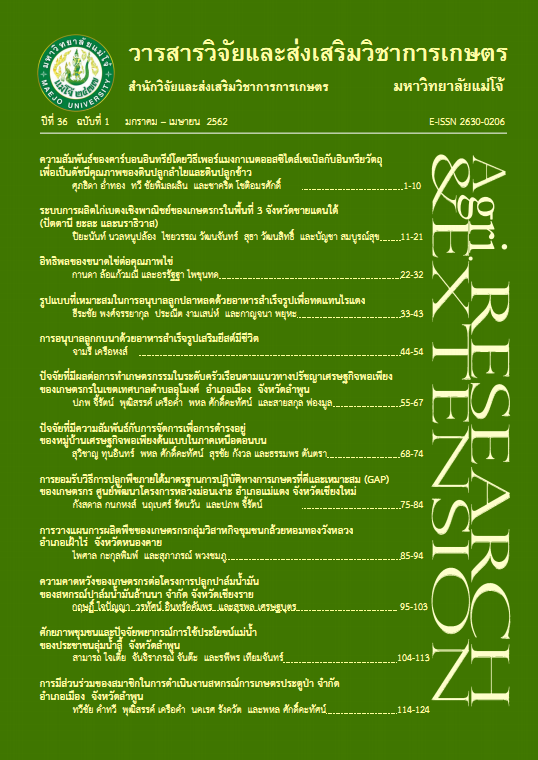Effect of Egg Size on Egg Quality
Keywords:
egg size, egg composition, egg qualityAbstract
The objective of this study was to evaluate the effect of egg sizes on egg quality. A total of 200 eggs obtained from 66 weeks old CP brown laying hens were used in this experiment. The eggs were separated by egg size containing group 1 (egg grading No.1 = 65-70 gram) group 2 (egg grading No.2 = 60-64.99 gram) group 3 (egg grading No.3 = 55-59.99 gram) and group 4 (egg grading No.4 = 50-54.99 gram) and kept at 26.80°C and 72.60% relative humidity. The storage periods were 0, 1, 2, 3 and 4 weeks. The results were found that egg size had no effect on Haugh unit, weight loss, pH of albumen, lightness (L*) of egg yolk and egg yolk color from egg quality machine at 0, 1, 2, 3 and 4 weeks of storage time (P>0.05). However, egg size had effected on pH, redness (a*) and yellowness (b*) of egg yolk (P>0.05). The results indicated that the egg grading No.3 and 4 showed better redness (a*) and yellowness (b*) of egg yolk than egg grading No.1 and 2 stored for 4 weeks that still relatively maintain egg consumers prefer dark-red or yellow of egg yolk.
References
Jones, D.R. and M.T. Musgrove. 2005. Effects of extended storage on egg quality factors. Poultry Science 84(11): 1774-1777.
Khamphadit, P. 2011. Effect of Egg Yolk Types and Processing Methods on Quality of Salted Egg Yolk. Pathumthani: Faculty of Agricultural Technology, Rajamangala University of Technology Thanyaburi. 34 p. [in Thai]
Kingori, I.A.M. 2012. Egg quality defects: types cause and occurrence: a review. Journal of Animal Production Advances 2(8): 350-357.
National Bureau of Agricultural Commodity and Food Standards. 2010. Thai AgriculturalStandard 6702-2553 HEN EGG. Bangkok: Ministry of Agriculture and Cooperatives. 15 p.
Patom, L. 2006. Poultry Production. Bangkok: Faculty of Agricultural Technology, King Mongkut’s Institute of Technology. 317 p. [in Thai]
Roberson, K.D., J.L. Kalbfleish, W. Pen and R.A. Charbeneau. 2005. Effect of corn distiller’s dried grains with soluble at various levels on performance of laying hen and egg yolk color. International Journal of Poultry Science 4(2): 44-51.
Samli, H.E., A. Agna and N. Senkoylu. 2005. Effects of storage time and temperature on egg quality in old laying hens. The Journal of Applied Research 14(3): 548-553.
Santaweesuk, S., U. Kanto, S. Juttuponpong and P. Rahitsun. 2000. Subsititution
of Cassava Meal for Corn in Layer Diets. pp. 248-255. In Proceedings of the 38th Annual Conference: Animals and Veterinary Medicine 1-4 February 2000. Bangkok: Kasetsart University. [in Thai]
SAS. 2002. SAS User’s Guide. V.6.12. Cary, NC: SAS Institute Inc. 89 p.
Scott, T.A. and F.C. Silversides. 2000. The effect of storage and strain of hen on egg quality. Poultry Science 79(12): 1725-1729.
Seedaruk, K. 2017. Effects of Storage Time on Organic Egg Quality in Refrigerator Temperature. Special problem. Sakon Nakhon: Kasetsart University Chalermphrakiat. 81 p. [in Thai]
Stadelman, W.J. 1995. Quality Identification of Shell eggs. pp. 39-66. In Stadelman, W.J. and O.J. Cotterill. Egg Science and Technology. New York: The Haworth Press Inc.
Supchukun, K. 2014. The Story of Eggs. Bangkok: Department of Livestock Development. 149 p. [in Thai]
Tilki, M. and M. Saatci. 2004. Effect of storage time on external and internal characteristics in partridge (Alectoris graeca) eggs. Journal of Veterinary Medicine 155(11): 561-564.
USDA. 2000. Egg-Grading Manual. Agricultural handbook No. 75, Review July 2000. Washington, DC.: United states Department of Agriculture. 50 p.
Downloads
Published
How to Cite
Issue
Section
License
Copyright (c) 2019 Journal of Agricultural Research and Extension

This work is licensed under a Creative Commons Attribution-NonCommercial-NoDerivatives 4.0 International License.
This article is published under a Creative Commons Attribution-NonCommercial-NoDerivatives 4.0 International License (CC BY-NC-ND 4.0), which allows others to share the article with proper attribution to the authors and prohibits commercial use or modification. For any other reuse or republication, permission from the journal and the authors is required.


